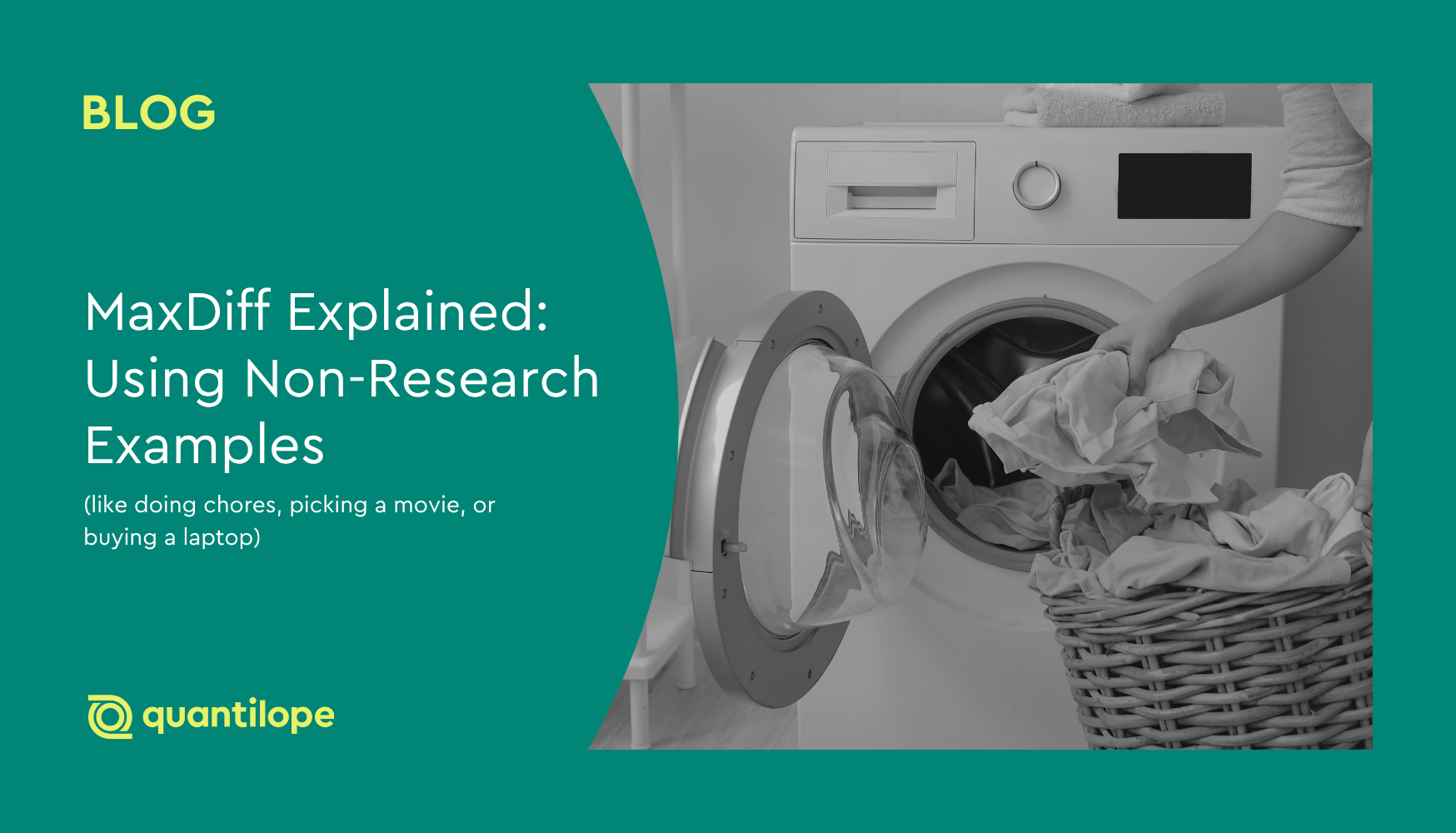In this blog, we look at how market segmentation can help bring a deeper understanding of the target market, and how marketing and sales activities benefit as a result.
Table of Contents:
- What is market segmentation research?
- The benefits of market segmentation
- Types of market segmentation research
- How to segment a market with the help of research
- What should your market segmentation strategy be?
- Market segmentation examples and use cases
- How to avoid common market segmentation mistakes
- How quantilope can help with market segmentation research
What is market segmentation research?
Market segmentation research takes a sample of people who are representative of a particular target market and then divides them up into segments. Within each segment, individuals share certain traits, needs, or attributes. The most common types of segmentation revealed by market research are:
Need-based Segmentation
What customers are looking for in a product. This will include needs that are currently being met, as well as unmet needs that can be tapped into with new products - such as what consumers need out of a breakfast cereal (energy, taste, convenience).
Need-based segmentation is considered the gold standard in segmentation work. That’s because it closely explores what consumers actually want and need out of products and services, making the segmentation outcome super actionable for brands.
Behavioral Segmentation*
How customers behave. For example, how much breakfast cereal do they buy per month? How many different varieties of cereal do they have in their kitchen cupboards? How do cereal product choices differ by household members?
Attitudinal Segmentation*
How customers' attitudes affect what they buy. For example, how do attitudes toward health and wellness impact breakfast cereal purchases? What about practicality? Which emotional associations do consumers have with cereals?
*Behavioral and attitudinal segmentations are often grouped together into ‘Usage and Attitudes’ surveys, as behavior and attitudes are closely related. These types of studies are often referred to as psychographic segmentation studies, focusing on consumer attitudes and values.
Demographic Segmentation
Who customers are. Their age, life stage, gender, social class, and where they live (as a few examples).
Often demographic segmentations aren’t enough in themselves to define different segments sufficiently. That’s because individuals tend to show more similarities based on their attitudes and behaviors, not on surface-level characteristics. Demographic information can be used as a secondary means of defining segments, but at their core, segments are better defined by needs, behaviors, and attitudes.
quantilope users can interpret their segmentation findings in just seconds with the help of the platform's AI assistance:

The benefits of market segmentation
Market segmentation moves beyond seeing a customer base as one mass of people toward a deeper understanding of the differences between separate clusters of consumers. While two consumers might be buying the same product, they could be doing so for completely different reasons. Gaining an insight into what those reasons are will reveal how a business can best encourage people to buy into, or more of, a product or service.
More relevant messaging
Knowing who your different groups of consumers are means you can talk to each in the right way. What motivates one group might be different from another, so customer segmentation means you can tailor product development, sales, and marketing strategies accordingly.
Let’s consider a scenario where there are two people who buy the same product but for different reasons. Imagine that both are 45-year-old men and both are in the market for oatmeal. One is buying it because his children love eating oatmeal before they go to school, so he wants a quick-cook product that pours easily from the box and into which he can stir blueberries for one child and honey for the other. He needs something that doesn’t spill everywhere while he’s rushing around the kitchen getting his kids ready for school. The other male consumer is taking his oatmeal into the office and eating it at his desk, so he wants individual pouches that he can grab from home in the morning and then heat up in his office microwave. He needs an oatmeal product that is quick, convenient, and will power him throughout his workday.
These two consumers appear identical on the surface in terms of age and gender, but have two totally unique needs: a product that kids love and that is versatile enough to have other ingredients added to it, and another that is quick and convenient. Brand communication to each of these various oatmeal consumer segments will need to reflect different values and needs to make each consumer feel that the product is right for them.
Standing out from the competition
As seen above with regard to relevant messaging, in-depth knowledge of consumer motivations, needs, and behaviors help make consumers feel heard and understood. As a result, consumers will gravitate toward the brands they feel effectively reach them. A key part of segmentation is identifying the language used by customers; if this is reflected in brand positioning and communication, they are more likely to feel that the brand understands them and that the brand's offer is most relevant amongst the competition.
Improved brand loyalty
Quite simply, when customers feel a brand understands them and meets their needs, they’re more likely to remain loyal to it. Loyalty means a steady stream of income for brands, making segmentation investments well worth it.
Lower acquisition costs
Leveraging segmentation means understanding who people are and what they're like so you can acquire and reach the appropriate group of customers right from the start.
Segmentation can also reveal where customers get information about a brand so that businesses can tap into the channels where the messages will be received. Digital channels such as social media are instrumental in marketing, so if you know where each of your segments is spending the most time digitally, placing messages in those places is a relatively low-cost way to attract new customers.
Driving growth and profit
Knowing each segment in depth helps a brand stay on track with its marketing communication and market development. It identifies which groups are ready to buy more from a brand, which require new products to stoke their interest, and which groups already have what they need and are less likely to spend. On the subject of spending, segmentation also helps identify which price points are likely to appeal to different groups of consumers so that pricing can be set appropriately.
Types of segmentation research
Segmentations can be carried out through a number of methods, as detailed below.
Quantitative survey research
Perhaps the most common, respondents are interviewed via an online quantitative survey, and responses and demographic data are analyzed using cluster analysis algorithms. Depending on the questions asked, results show how groups differ in terms of factors like behaviors, needs, attitudes, and price sensitivity. They also show the relative size of each segment, useful for knowing how valuable a group of people will be to a brand.
Qualitative research
Qualitative research is adept at putting the ‘flesh’ on segment profiles and is usually carried out in conjunction with quantitative research. It can be used to explore customers’ needs and attitudes before quantitative research, as well as to provide a fully rounded picture of each segment once quantitative research has established what the segments are. As such, qualitative research on its own is not a substitute for quantitative segmentation research but works great in partnership with it.
Focus groups, in-depth interviews, and ethnography studies are the main qualitative methodologies used for segmentation. All of these allow respondents to explain in their own words what they think, which is invaluable in collecting consumer language for communication strategies. Ethnography even allows researchers to ‘live’ the customer experience as respondents demonstrate how they use a product or what their need is.
How to segment a market with the help of research
The market segmentation process involves first identifying who makes up the overall target market for your brand. Sales, CRM, and social media data can all be good sources of information on who is currently buying your brand, who is buying from competitors, and who isn't buying from the category at all but may be interested. All of these people make up your market, so you'll want to hear views from a sample that's representative of each of these groups.
Armed with the fundamental criteria that define your market - for example, the age range, geographical location, purchase behavior, any known attitudes, and lifestyle types - it's time to start creating profiles through screening questionnaires in your survey. Screening criteria will help further classify your target market based on additional needs, attitudes, behaviors, and other criteria.
Using online survey platforms, creating the rest of your market segmentation study is very straightforward. Following the screening questions, your survey will ask respondents about their relationship with your brand: purchasing habits, brand usage, brand attitudes, needs, and so on. Findings from the survey then show how people think and act in relation to your brand or category. Those with similar feedback will be clustered into discrete groups, creating actionable segments for a brand to target.
As well as identifying the segments of consumers that exist in your market, research often sizes the market too, indicating the size and value of each segment for your business. This gives an idea of which segments you should concentrate on for the best return.
Back to Table of Contents
What should your market segmentation strategy be?
Market segmentations can be highly valuable cornerstones on which to base marketing and sales activity. They need to be solid and reliable, containing information that will be most useful for your business decisions.
Determine what your segmentation is based on
The first thing you need to decide is how best to segment your market - whether it should be based on needs, behaviors, psychographics, or attitudes. This will differ by category, so it's worth asking yourself which pieces of information will be most valuable for developing your business. If you're selling face cream, needs will be high on the agenda (e.g. needs for a youthful glow, a lack of wrinkles, moisturization...) while a transit company might be most interested in passengers' behavior by day of the week, and a political party might be most interested in attitudes. Establishing from the start which type of segmentation is most relevant to your business is essential. If you don't have a strong idea of what that might be, start with a need-based segmentation as you can always filter data down by other demographic or psychographic variables later on (assuming you've asked these kinds of questions in your survey).
Decide the purpose your segmentation will serve
You also need to think about how you will use the segmentation once it's done. Will it guide product development? Messaging? Pricing? Packaging? Knowing how you want to use the findings will help shape your survey questions and deliver the right information at the end of the study. For example, as part of your main survey, you might want to gather attitudes about how much people are willing to pay for your brand, or which category messages are most motivating for them. You might also want to plan an ongoing tracker amongst your segments, monitoring any changes in needs, behaviors, or attitudes over time.
Back to Table of Contents
Market segmentation examples and use cases
To further illustrate how segmentation might be used, here are some examples.
Haircare
Imagine you're a women's haircare brand with a portfolio of products offering a variety of benefits. Traditionally, you've focused on what the products do for hair - such as adding moisture, making it stronger, detangling, etc. - but you've recently noticed on social media that consumers are talking more about how they want products to make their hair look. As women differ by hair type, the aspirations they have for their hair, and the types of products that attract them, you'll want to figure out a way to segment these haircare consumers into niche and actionable segments to effectively sell your products.
Given the different needs consumers have when it comes to haircare products, a need-based segmentation approach would work best here to find out what drives product purchases. These needs could be to: 'obtain shiny, clean hair', 'get more defined curls', 'create bounce and movement', and so on. Pinpointing these needs helps the brand develop products that give consumers their desired look, and speak to them in the language they use so that they feel the products are relevant to them.
Once you've created segments grounded in haircare consumer needs, you can further classify segments depending on other hair criteria asked throughout the survey (i.e. if their hair is curly or straight, thin or thick, how often they wash their hair, etc.). All these variables can contribute to highly-catered products for each segment of consumers.
Financial planning
As another example, a financial planning firm might want to segment its market based on attitudes, as they know this is what ultimately drives people's behavior around their finances. For example, if they identify one segment that is ignorant about their money and another segment that considers themselves 'money experts' and deals with finances every day, the firm will know to take different approaches with each segment in order to sell its services. The type of language they use with consumers who lack knowledge about financial products will need to be more engaging and educational in nature. In contrast, for those already in the know, the financial firm might want to use more complicated jargon in communications so they feel like an important and established audience.
As another option, if the financial firm instead wanted to run a need-based segmentation, they could uncover what each segment needs from their financial planning services - such as a need to learn more, to feel reassured, to have someone help with financial problems, to dive into investment opportunities, or to feel well-informed about the latest trends.
Back to Table of Contents
How to avoid common market segmentation mistakes
Segmentation is a powerful market research method to better understand and target your audience. However, there are some common mistakes you'll want to make sure to avoid in your study:
Not asking enough questions
To successfully segment a market, your research study needs to include all possible areas of inquiry that will provide valuable context into your segments. It might not be obvious from the start as to how a brand's market will be best segmented, so it's important to gather as many details as possible to really define and differentiate each segment from one another.
Over-simplification
One of the biggest mistakes made with segmentation research is the assumption that each consumer fits neatly into one segment. In reality, this can't always be true. Humans are complex, and needs and attitudes can change; people might sometimes fit into one segment but also have needs that place them in another. It's worth looking at when and why those needs change - it might be occasion-based (straight sleek hair for the workplace, tousled hair with glitter for a night out, etc.) season-based, or mood-based, but it's worth uncovering those nuances that help target messaging appropriately.
Segments are mutually exclusive categories, meaning each respondent will only be able to fit into one group (despite possibly having some qualities of multiple groups). One way to minimize the impact of these situations is to use the data to help you determine the right number of segments. Your team will want to include enough groups so that the market isn't forced into too few groups, while not having so many segments that they start to become similar to each other.
Not keeping segments up to date
A segmentation study is a great way to reveal important context about the different types of consumers that make up your target audience. However, things can change over time and in different scenarios (as mentioned above) so it's a good idea to re-run your segmentation every so often or to run other research studies alongside it to keep tabs on how any potential changes in the market could impact your brand's decision making.
How quantilope can help with market segmentation research
With quantilope, you can conduct a needs-based segmentation study through the online platform from start to finish. Start by selecting respondents from your target audience, then decide on the questions you want to ask in the survey. This stage takes some thought, as you need to make sure your questions reflect the type of segmentation you would like to achieve, and quantilope consultants are always available to help, should you need it. Once responses start coming in from the survey, quantilope’s AI-driven analysis tools will sort respondents into groups of customers and define how they differ from each other.
To gather consumer language and gain a more in-depth experience of consumer attitudes and usage, quantilope’s video research solution, inColor, provides a qualitative lens to segmentation work. Video footage of consumers brings segments to life, and emotional and facial analysis help unearth subconscious needs and views.
To learn more about quantilope's automated, need-based segmentation, get in touch below:




.png)